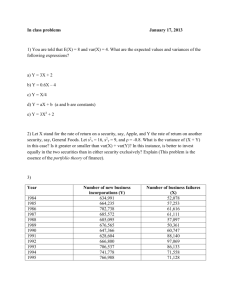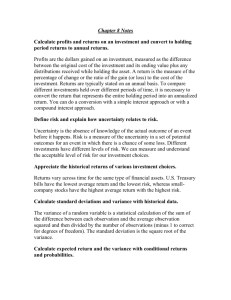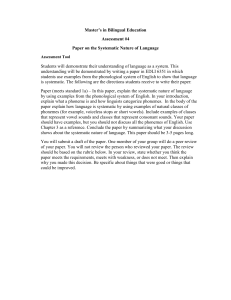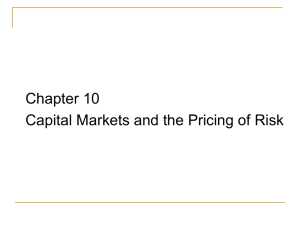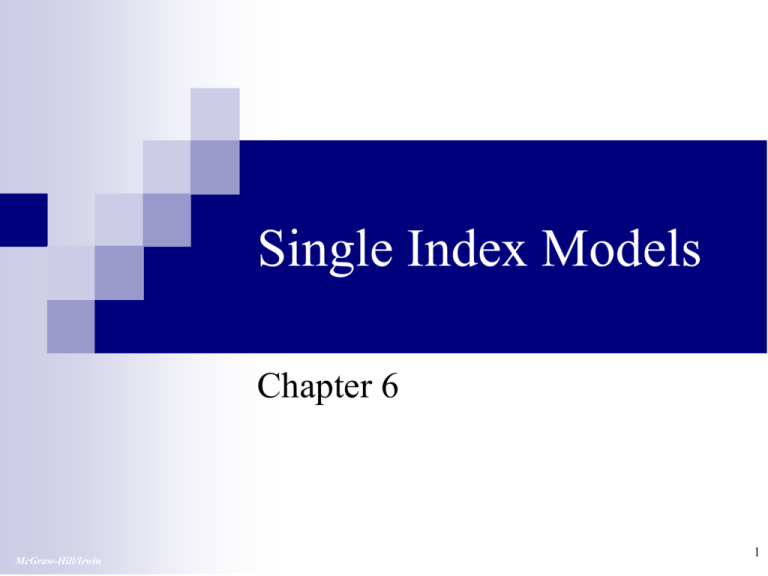
Single Index Models
Chapter 6
McGraw-Hill/Irwin
1
Copyright © 2013 by The McGraw-Hill Companies, Inc. All rights reserved.
WARNING! DANGER!
To date we have been mostly solving problems
We are now beginning the VERY
CONCEPTUAL component of the class
Instead
of simple being able to solve the problems
you need to understand the theoretical concepts
and their implications
In general this will require a much deeper
understanding of the material
Please be prepared
2
6-2
Learning Objectives
Describe the advantages of a single-factor
model
Define systematic risk and firm-specific risk
and estimate the contribution of each to a
firm’s total risk
Describe the relationship between firmspecific risk and portfolio diversification
Identify the inputs of the single index model
and describe the security characteristic line
6-3
return
Where we left off
Optimal Risky
Portfolio
CAL
Efficient Portfolios
Risk
Free
P
4
6-4
Single Index Stock Market
In the real world constructing the efficient
frontier is practically impossible
Too
many interactions
However, we can simplify by assuming that all
co-movement in returns results from a single
risk factor
Idea
is that a single common risk factor
(systematic) is responsible for all the co-movement
in returns
5
6-5
Assumptions: Single Index Model
Returns are driven by a single, common systematic
factor
Stock
The factor is systematic (Macroeconomic) affects
everything
measures a securities sensitivity to the factor
returns are joint normally distributed
Varies across securities
Firms are correlated with each other through their
correlation to the systematic (macroeconomic) factor
Macroeconomic
surprises and firm-specific surprises are
not correlated
Firm specific surprises are not correlated across firms
6-6
Single Index Stock Market
ri = βirM + ei + αi
A stocks excess return (ri)has three parts
1.
Return due to movements in the risk factor: βirM
is the market’s excess return
βi is the sensitivity of the security’s returns to the
market factor; Systematic risk measure
rM
Βi > 1: Cyclical stocks
Βi < 1: Defensive stocks
Return due to firm specific events: ei; Residual risk
3. Return beyond that induced by the market: αi
2.
Under or Over priced
Remember excess return → net of risk free
7
6-7
Where Does αi Come From?
Stocks have two values:
Intrinsic
Value (IV) the present value of the
expected future cash flows
“True” Price according to a valuation model
Market
Value (MV) is the consensus value of all
market participants
αi is postive when IV > MV, Under-Priced
αi is negative when IV < MV, Over-Priced
αi is 0 when IV = MV, Correctly Priced
8
6-8
Single Index Stock Market
ri = βirM + ei + αi
ri is
the security’s excess return
rM is the market’s excess return
βi is the sensitivity of the security’s returns to the
market factor; Systematic risk measure
Βi >
1: Cyclical stocks
Βi < 1: Defensive stocks
ei is firm-specific or residual risk
Surprises,
return independent of market factor
αi is the stock’s expected return beyond that induced
by market index; Under or Over priced
9
6-9
Breaking Up Returns
A stocks excess return has three parts
Return due to movements in the risk factor: βirM
2. Firm Specific unexpected events: ei
3. Stock expected excess return: αi
1.
Is the stock under or over priced
10
6-10
Single Index Graph
ri = βirM + αi
Security
Characteristic
Line
11
6-11
Security Characteristic Line
Does NOT depict actual returns
Does represent average tendencies
Provides
rD
the security’s expected return given rm
= βDRM + αD
ei is
assumed to be 0
12
6-12
Example
If we expect the market to return to be 15%,
what return do we expect from a stock with a β
of 1.2?
If its α is 3%?
What about if the market only returned 13%?
If e is -1%?
13
6-13
Expect versus Realized Returns
E(ri)
ri
ri E (ri ) i F ei
Actual return = Expected return + the effect of
surprises
ri = Actual return earn on the security
E(ri )= Expected return on the security
βi= Factor sensitivity or factor loading or factor beta
F = Surprise in macro-economic factor (+/-)
ei = Firm specific events
14
6-14
Expect v Actual Return Example
If the market is expected to return 12% over
the next year, what is the expected return for a
stock with a β of 1.2? The risk free rate is 3%.
If the actual market return was 9%:
What
is the market surprise?
What was the actual return earned over the year?
15
6-15
Breaking Down Variance
Variance is a measure of TOTAL risk
Variance
= Systematic risk + Firm-specific risk
Systematic risk = βi2σm2
Firm-specific risk = σ(ei)2
σi2 = βi2σm2+ σ(ei)2
For a well diversified portfolio, what does
σ(ei)2 equal?
16
6-16
Variance Example
What is the variance of a stock with a beta of
0.9, if the standard deviation of the market is
25%, and its residual standard deviation is
30%?
What if the market standard deviation
increases to 28%?
17
6-17
How Important is the Market?
To determine the importance of systematic risk we
measure the ratio of systematic variance to total variance
This is the correlation coefficient squared
As ρ2 increases → the market is more important for
explaining firm returns
σ2(eD): variance of firm specific surprises
Determines spread of actual returns around SCL
Influences the importance of the market
18
6-18
Single Index Graph
ri = βirM + ei + αi
β: Systematic risk
-Steepness
Spread for the SCL is
idiosyncratic risk
19
6-19
Diversification in a Single Index
World
All securities have systematic risk exposure, β
Can’t
get rid of this
Portfolio β is just a weighted average of the
stock in the portfolio
20
6-20
Diversification Continued
Variance of the equally weighted portfolio of
firm-specific components:
2
1 2
1 2
(eP ) (ei ) (e)
n
i 1 n
n
2
When n gets large, σ2(ep) becomes negligible and
firm specific risk is diversified away.
Questions
Which offers more diversification benefit?
Which is riskier for an undiversified investor?
Which is riskier for a diversified investor?
22
6-22
Does investment horizon matter?
This is hotly debate
Many belief that long term investors should
hold more stock (riskier assets) because they
become less risky over the long run
Time
Diversification
The book and many academics argues against
this position
23
6-23

